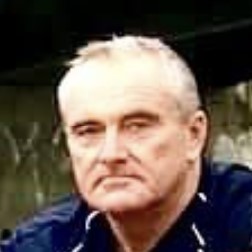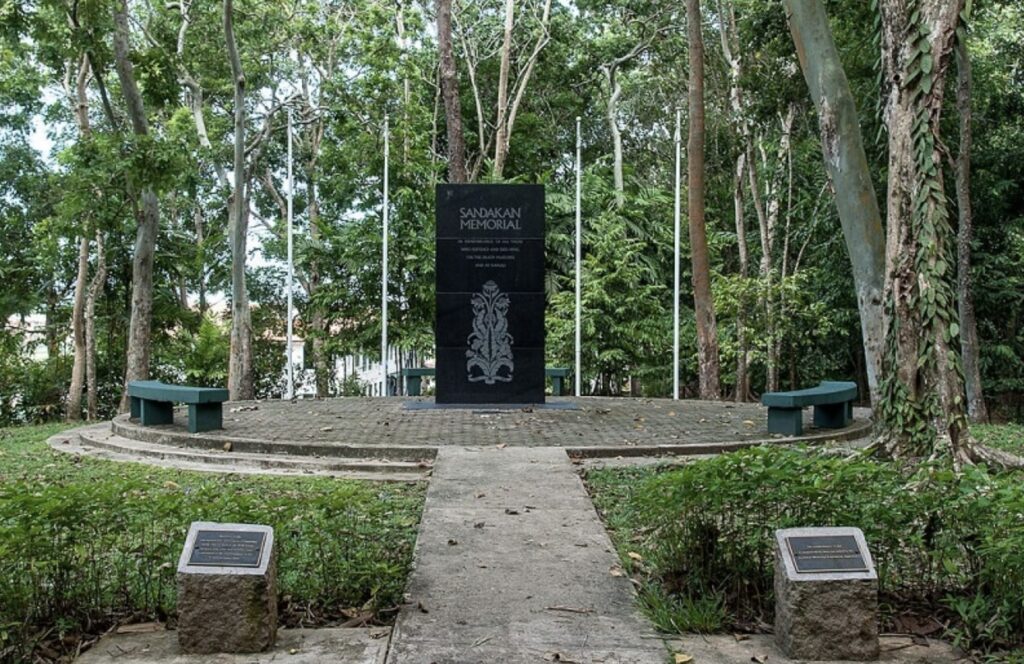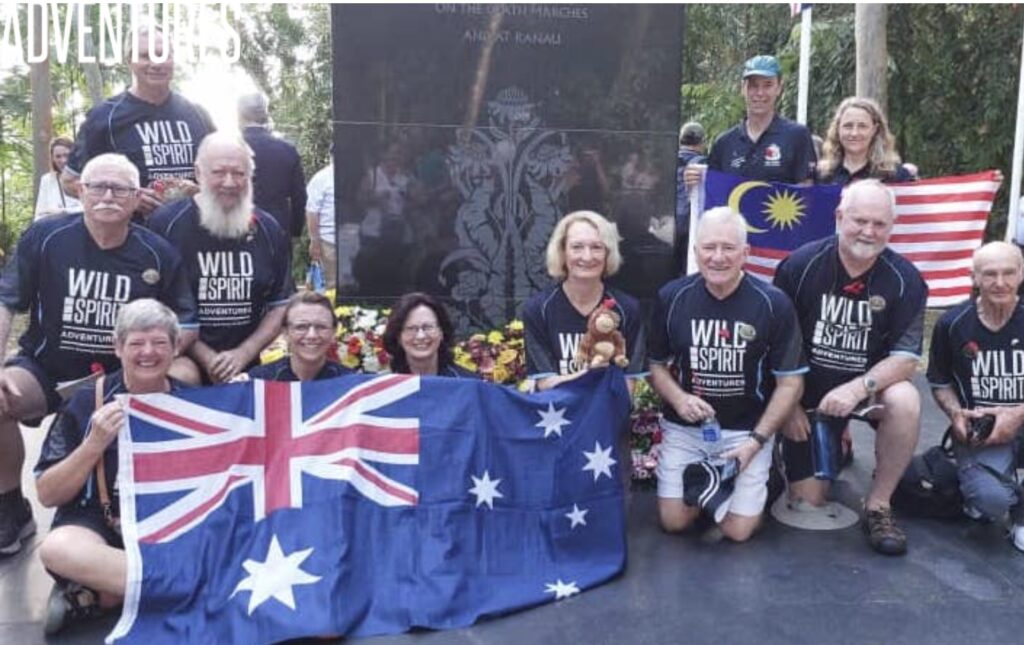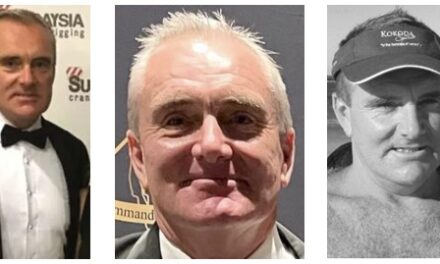Wayne Wetherall

Wayne Wetherall, a former suburban air-conditioning salesman turned self-proclaimed intrepid explorer, adventurer, philanthropist, and historian built a successful trekking model for his Kokoda Spirit company based on a series of bogus claims and shameless marketing.
Wetherall was quick to learn there are no marketing boundaries in 3rd World countries such as PNG and Borneo – as a result it is relatively easy to flout rules and regulations relating to trademarks and copyright material – It’s also easy to make bogus claims and move on when they are expiosed!
Wetherall successfully developed his Kokoda Spirit business by shadowing our Adventure Kokoda website and copying material that had taken us 12 years to develop before he ‘discovered‘ the business opportunities presented by the emerging Kokoda trekking industry in 2004.
He later established more companies using the same formula, Sandakan Spirit, True Spirit Adventures, and Wild Spirit Adventures.
In his December 2011 blog Wetherall reinforced his description of himself as an:
‘expert trekker, passionate adventurer, and passionate historian’.
and then goes on to describe his ‘discovery of Sandakan as the result of years of research and hard slog through the Borneo Jungle!
Sandakan Spirit
In developing Sandakan Spirit to lead treks across the Sandakan Death March Route he shadowed Lynnete Ramsay Silver AM, author of the highly acclaimed book ‘Sandakan – A Conspiracy of Silence.
Wetherall used the same techniques as he used on the Kokoda Trail by claiming to have ‘opened up Sandakan‘ and ‘discovering ‘part of the original death march route’.
Lynnette Silver, a meticulous historian, author of 10 published books and the official historian for the Australian 8th Division Association was aghast at bogus claims by Wetherall in promoting his Sandakan Death March treks however she was no match for his bogus marketing techniques.
On 11 February 2009 Wetherall advised:
The Brisbane Courier Mail – 7 August 2011
‘A Sippy Downs adventurer and historian says he has found missing links to Australia’s greatest single World War II tragedy, the Sandakan Death March,
‘‘Wayne Wetherall, of tour group Sandakan Spirit, says research, interviews, maps and journals have led him to discover 20km of track lost for more than 65 years . . .
‘Now, Mr Wetherall is adamant he has discovered the “correct” track, with 20km previously unknown across the Maitland ranges between the post-war relocated villages of Mangkadai and Miruru (Milulu).
“You can feel the energy coming out of the ground. This is a significant part of our history,” he said.“It is imperative that the recording of the history of this track is correct. We hope this can be shared with other historians and other people to get a truer picture of what happened out here.
“On our last few trips there we’ve come to realise that tracks run in different directions.”
‘Mr Wetheral said he expected his claims to cause controversy in the history community.
“Some of the information in the past has been quite sketchy,” he said. “There will be some controversy involved, no question, but we believe this is a new section of track.
“We’re not saying that anyone else is wrong, just that we want to get this track right.“It’s an evolving track and we’re finding out more and more about it.”
‘He said he used documents including Japanese records and death certificates of POWs to put the jigsaw together.‘He also interviewed carriers on the original track, now aged in their 90s.
“This has all helped us put together the missing pieces,” he said.“
They spoke about the way the track ran and what they witnessed. They have very descriptive stories.“Carriers were under threat of death if they assisted POWs in those days.”
‘Mr Wetherall and his team will return this Friday to investigate another new section of the track at Lalosing, a dense forest that was once a Japanese camp and POW site during the second world war.‘He will be led by an original carrier from the Death March, named Ambugang, and his son, the chief of Miruru village.
“We will be the first to go into Lalosing since the war,” Mr Wetherall said.“It’s part of the state forest now, we had to seek permission from the Malaysian Government to do it.”
‘He said Sabah Tourism, the Malaysian Government’s tourism office, supported his claims of the new track.
“The history and correct route that these courageous POW walked need to be documented correctly so future generations of Australians can walk in the footsteps of these heroes,” he said.
“We also have a small window of opportunity to interview the surviving locals who witnessed the atrocities before they take this knowledge to the grave.”
‘He said these locals collaborated with him twice.‘Next week is also an important day in the history of the Death March.‘The Sandakan Day Memorial, on August 15, commemorates those who died and suffered on the Death March.’
Link: Sandakan’s deadly past
Wetherall’s self-proclaimed ‘historian’ status was betrayed by his statement that he ‘could feel the energy coming out of the ground’ – he was obviously unaware that ‘history’ is more than a vibe!

Lynette Ramsay Silver AM MBE
He also failed to acknowledge the extensive research of Mrs. Lynnette Silver AM had conducted on Sandakan over the previous decade. Mrs. Silver is the official historian to the 8th Division Association. Her research was published in her book ‘Sandakan – A Conspiracy of Silence’, a decade before Wetherall’s ‘discovery’ of the place.
Her research involved painstaking research and interviews with survivors, as well as a study of Japanese records, pieced together a detailed and highly readable account of the lives and ultimate fate of Sandakan’s POW’s. The integration of first-hand accounts and historical records forges a merciless portrayal of the crisp trepidation and unwarranted deception behind what has become WWII’s darkest and most deadly secret.uncovered the fate of 2428 Australian and British prisoners of war who died at the Sandakan POW Camp in Borneo on one of the death marches, and investigated the coverup of a failed rescue mission Operation Kingfisher (World War II). 2004’s The Bridge at Parit Sulong is an investigation into the massacre of allied prisoners by Japanese soldiers in Malaya in 1942. Further books, mainly related to military history, followed.
Silver was awarded an honorary Medal of the Order of Australia (OAM) in 2004 for “service to veterans and their families, particularly as an organiser of battlefield tours and commemorative services”.[1] She was advanced to Member of the Order of Australia (AM) in the 2019 Australia Day Honours for “significant service to the community through historical battlefield tours and commemorative services”,[2] and appointed a Member of the Order of the British Empire (MBE) in the 2024 New Year Honours for services to British families of Second World War personnel.[3]
Mrs. Silver contested Wetherall’s claims in the following blog:
‘The death march track opened up by Tham Yau Kong and Lynette Silver in 2005 follows as closely as is practically possible the route taken by the POWs, retraced and recorded by an Australian Army War Graves team in 1945.
‘The original hand-drawn map plotting this path was given to Lynette in 1995 by Corporal G Robertson, the soldier who drew it.
‘A copy, based on the original, is preserved in Australian Archives and is on public display at the Australian Government Commemorative Pavilion at the Sandakan Memorial Park.
‘A copy of Lynette’s original map is displayed at the Kundasang War Memorial.‘In August 2011, Wayne Wetherall, an Australian tour operator, claimed in media reports that the route being followed by trekking parties was incorrect, and that the POW route had deviated into the Liwagu Valley, to pass through the village of Miruru.
‘He also claimed he had ‘discovered’ a ‘lost’ section of the track, deep in primary jungle.‘Following this announcement, a letter by a Sabahan ‘History Buff’, concerned by the veracity of these claims, was published in Sabah’s Daily Express, initiating a public debate. Lynette’s statement, compiled at the request of the newspaper editor, can be accessed at http://www.dailyexpress.com.my/read.cfm?NewsID=750. Further transcript and additional commentary is at http://blog.kokodatreks.com
‘Reports and body-recovery documentation, the copy of Robertson’s map and wartime maps prepared from intelligence gathered during hostilities by secret agents are held in Australian Archives. This material, coupled with first-hand knowledge provided by several local people, who had walked the track many times while ferrying supplies for the Japanese, show that the POW route did not, at any stage, enter the Liwagu Valley or pass anywhere near Miruru village.
‘This research, carried out by Lynette in the 1990s, and re-checked in 2005, was confirmed in early 2012 by Army historians and mapping experts who, following the 2011 claims, were given the task of making an independent assessment based on all the archival and other evidence. In April 2012 , the Australian Government formally released an official map showing that the death march track followed the route plotted by Robertson. No evidence was found to support the 2011 claim that the track had deviated into the Liwagu Valley or passed through through the village of Miruru.‘Furthermore, the ‘lost’ section had never been lost.
‘It is highly protected Class 1 Forest Reserve, entry to which is prohibited without special permission. It is also in a high risk ‘flash flood’ zone.
‘In the interests of safety, and for environmental and conservation reasons, trekking groups have always used a nearby alternate path, which is safer and far less environmentally-intrusive route.‘For an investigation of the death match route, go to the followqing links:
Mrs. Silver’s confirmation that the ‘lost’ section of the Sandakan Death March Route has never been lost could be applied to Wetherall’s previous claims of lost and forgotten battlefields along the Kokoda Trail which have also never been ‘forgotten’ or ‘lost’.
Mrs. Lynette Silver’s extensive research on the route of the Sandakan death march route can be read on this link:
In the article Mrs. Silver advises:
‘The official documents used to compile this article are all held in Australian National Archives or the Australian War Memorial Collection. The transcripts of interviews, along with the videoed and audio recordings with local people, are preserved in the Silver Papers. A fully referenced version of this paper is held in the Archives of the Sabah State Museum.
However, this did not deter Wetherall from belittling Mrs. Silver’s research by advising:
‘After 79 years, you can walk the Sandakan Death March track in the footsteps of those heroes.
‘With Sandakan Spirit as your trekking company, you’ll be participating in both a personal discovery experience and an historic Borneo adventure.‘That’s because our treks across the Sandakan Death March follow the original route as closely as possible. We avoid using “short cut”, “eco” or alternative tracks that are logistically easier, ensuring that you see the real Borneo, and the original Sandakan Death March Route. . .
‘We avoid using short cut or alternative treks that are logistically easier to ensure you see the real Borneo, the real Sandakan Death March Route. We use a variety of accommodation on our treks including camping next to Rainforest Rivers and staying in traditional Dusun Villages along the way, this gives you a great chance to embrace the traditional culture and mix with the locals and hear firsthand the stories of their forefathers.‘If you are comparing Sandakan trekking companies, make sure you are on the correct route.’
Link: Sandakan – Borneo
Route to Great Cruelty
He closed his blog with the expected advertisement for his business:
In an article titled ‘The route to great cruelty’ the New Strait times in Sabah reported:
‘ He (Wetherall) said the lost route was discovered based on information from various sources such as the Australian War Graves, grave recovery maps, National Archives and Australian War Memorial.
“Some of the most compelling intelligence that we have gathered came from local people along the route, including the village chiefs of Taviu, Mankadai and Miruru in Ranau,” Wetherall said.
Unlike Mrs. Silver, Wayne Wetherall does not reference any of the ‘compelling intelligence’ he gathered from village chiefs and does not provide any GPS readings to support his ‘research’ as would be normally expected of a ‘passionate historian’ as he claims to be.
‘Profit Motive’ in new Death March
The following letter, ‘Profit motive’ in new Death March, published in the Daily Express (East Malaysia) by ‘History Buff’ on 25 September 2011 indicates that Wetherall adopted the same ambush marketing strategy on the Sandakan Death March route as he used to develop his business along the Kokoda Trail:‘
A so-called ‘expert’ has lately surfaced making claims about newly-discovered ‘lost tracks’ of the infamous Death March route of World War Two.
‘He has made claims he has spoken to villagers and the original route used by the POW’s and the Japanese near the village of Miruru when this is not the case.
‘A number of villagers interviewed in the Miruru area deny ever speaking to him and the Sabah Society research of 2005-2006 concluded the route did cut through the Miruru area before the prisoners had to wade across a major river to get to Tampias.
‘The issue, however, was if they carried on through the marshland to get to the river before crossing over or went up the top of the ridge and back down to cross over. This has never really been proven even till today.
‘The Sabah Society’s findings differ from author Lynette Silver and her research but this has not caused problems thus far as most experts agree it is hard to determine the actual route given there were several marches between Sandakan and Ranau and because prisoners were executed and marched along different parts of the section in question during that period of time.
‘So it is impossible to prove anything beyond reasonable doubt.
‘Much of what this Australian ‘expert’ claimed appears to be old news as the Sabah Society and Tham Yau Kong had done much of the work in 2005 establishing the actual route and the use of Miruru during the actual march before this Australian even got to Sabah and walked the route with Tham several years later . . .
‘We now have a situation where an Australian is now claiming to have made dramatic discoveries when it clearly isn’t the case and is using this to gain media mileage at the expense of Sabahans.’
Wayne Wetherall’s Writings
A review of Wetherall’s writings regarding his ‘discovery’ of Sandakan are similar to the approach he used to differentiate himself from other tour operators in the development of his Kokoda Spirit business six years earlier via his website blogs[i]
Unlike Lynette Silver he does not reference any conversations he has supposedly had with individuals along his version of the Sandakan Death March Route, nor does he provide any GPS readings to support his assertions.
‘it was like entering a lost world, the jungle was thick, dark, steamy and brooding.
The track was steep, slippery, brutal and unforgiving, it was difficult staying upright. No white man had trekked this toughest section of the track since the POW’s marched it 66 years ago . . .
This is an important find and is now part of our standard itineraries for our treks. . . We avoid using “short cut”,“eco” or alternative tracks that are logistically easier to ensure you see the real Borneo, the real Sandakan Death March Route.
In a condescending slight to Sandakan historian, Mrs. Lynette Siver, he wrote:
‘It was great to read the article in the Sydney Morning Herald of the continued involvement of Miltary (sic) Historian and Veteran (sic) Trekker (sic) Lynette Ramsay Silvers (sic) association of walking and leading treks across the Sandakan Death March this year with Tham Yau Kong.
It is also interesting that it is possible to pay extra for Lynette Silver to accompany you on a TYK trek.
A review of Wetherall’s Kokoda Spirit website reveals that he adopts the same method on his treks across the Kokoda Trail as locally led treks are cheaper than those he leads!
On 3 August 2011 he issued a Media Release titled ‘Every Aussie has a right to know!:
‘CORRECTING AUSTRALIAN WAR TIME HISTORY!
‘Parts of the Lost Death March Track in Sabah Borneo uncovered.
Trekkers now on the right Track
The Sandakan “death march” is the greatest single World War 2 tragedy in Australia’s History. Yet this story remains virtually unknown to so many.
Wayne Wetherall an expert trekker and passionate historian has uncovered the lost sections of the “Death March Track” of Sandakan, he has become a voice for the thousands of brave Aussie Men who never came home.
Links:
Wetherall’s claim was contradicted by ‘History Buff’ in the Daily Express (East Malaysia) on 25 September 2011 (see above) who advised:
‘We now have a situation where an Australian (Wayne Wetherall) is now claiming to have made dramatic discoveries when it clearly isn’t the case and is using this to gain media mileage at the expense of Sabahans.’
On 21 November 2011 Wetherall posted a blog titled ‘Borneo Track Claim’
In the blog he attempted to justify his claim of to have discovered two new sections of the Sandakan Death March Route ‘after intensive research and interviews with those who witnessed the attacks on Australian soldiers’. According to Wetherall:
‘The real answers for us have been actually walking through the jungle and talking to the local people aged in their 90s now who were the carriers.‘His research also included piecing together information from the Australian Office of War Graves recovery maps, Japanese death certificates and the Australian War Memorial archives
He went on to explain:
“We were the first people to actually go into this section of the forest called Lolosing and it was primary Borneo jungle deep, dark, with vines coming down everywhere,” he said. “We had with us an 80-year-old who was a carrier for the Japanese, and he was showing us where the commander’s building used to be and where he saw an Australian soldier killed.
“It was chilling stuff to be there with him. It’s going to be an ongoing project because there is still much more left to discover.”
‘Over the past two journeys he and Jerome and his team of local Dusun’s, who are direct descendents of the carriers and villagers along the track have meticulously, using the latest in GPS mapping technology and old fashion hard work we were able to faithfully piece together as close as what they believe to be the original route.
He then fell back on the familiar mantra he used soon after he ‘discovered’ the Kokoda Trail six years earlier that ‘We see things as an explorer, historian and adventurer.
‘When you trek the Sandakan Death March with Sandakan Spirit, you’re participating in a personal discovery experience; you are truly living and participating in an historic and monumental Borneo adventure.‘After sixty six years, you too can now walk the Sandakan Death March track in the footsteps of the Sandakan Death March heroes.’
Lynette Silver’s Rebuttal
The last word goes to Mrs, Lynette Silver:
‘The Sabah Society walk, led by Tham Yau Kong in 2005, went the wrong way because author Kevin Smith, whom Wayne Wetherall relies upon, had produced a ‘map’ of the death march showing the track going through Miruru and Mangkadai villages.‘
He had latched onto the words Miruru and Mangkadai because I had given these places as places of death for POWS, as shown on Japanese wartime documents which Smith had never seen.‘
Well, when you appropriate someone else’s research you need to know what you are stealing.‘Miruru was the name given by the Japanese to the climb up Taviu Hill, and Mangkadai to a stretch to the east.‘
The reason for the naming was because the entire area was unexplored and uninhabited.‘
They had to bring in labour from villages in another valley, along the Labuk River.‘These villages, Miruru and Mangkadai, were far away, with Miruru on the far side of the Labuk. ‘
However, when a road was built linking Ranau to Sandakan in the 1970s, the villages moved to be closer to the new road, as they were no longer dependent on river travel.
‘Smith latched onto the words Miruru and Mangkadai and assumed they went through the modern day villages. He then published his shonky map in his book and it was taken at face value.‘
It was not until I asked why the Sabah Society had gone into the wrong valley that Tham Yau Kong found that Smith’s map was completely wrong.
‘When I produced the original 1945 map, drawn by the recovery teams, we were able to follow the rivers marked, crossing the numerous marked tributaries, to identify where the track went. The route was confirmed by at least five locals who had worked for the Japanese as coolies and had walked the track many times. They physically showed us where it went.
‘Wayne Wetherall got hold of Smith’s bogus map, and announced that he had found the correct path. His groups and those associated with him go completely the wrong way.
‘When challenged, Wetherall claimed that there was an ‘alternate’ route, despite the fact that villagers refute his story entirely. Business is business is the credo and unfortunately local business interests tainted by Wetherall’s claims have no interest in historical facts.
When you ascertain where old Miruru and old Mangkadai were, the absurdity of this claim becomes even more obvious.
Can you believe that a local guide took 100 serving members of the Australian Defence force on a so called death march trek very recently, following the bogus route?
In September Wetherall also took a group of students along the same route now promoted as the Sandakan Memorial Track.
Very embarrassing, given that the Australian defence experts produced the official map, with the Australian Coat of Arms on it, which was launched in 2016 to put an end to all this nonsense.
AND, someone connected to Smith (now deceased) has ALTERED the official map on display at Ranau to show the’ alternate’ route. It is behind glass, so I can’t rectify it.
To the uninformed It looks as if the government and defence agree that there is a second route, no matter how stupid that idea is.
2025 Update from Lynette Silver in Borneo
‘Far from endorsing the Wetherall route, Sabah Tourism Board has now produced, en masse and for free, a map of the route from Sandakan to Ranau, based on the official map produced by the Army History Unit and Army mappIng team. This map is universally accepted as correct, as it is based on the wartime map drawn by the war graves recovery teams.
‘One side shows the route, the other has 15 key places that can be accessed if travelling by car. Black and yellow signs, with six POW figures, have been erected to direct motorists.
‘The new map incorporates a viewing platform that overlooks the original tortuous climb along the Lolosing ridge. This passes through highly protected class 1 forest and is too dangerous for trekkers to use without express permission, rarely granted.
‘To date permission has only been granted to a British military group and an Australian army group, due to tackle it in August 2025, provided conditions are favourable.
‘Wetherall’s claim that he would be the first to venture into Lolosing is sheer nonsense. Tham Yau Kong and his jungle guides were the first, in 2005, when locating the route from the wartime map. Since then, one is allowed into that zone without the express permission of the forestry officials.
‘The new map should put to an end his ridiculous claim that the death march route went into the adjoining Labuk valley and passed through present day Miruru and Mankadai villages, which, in 1945 were a great distance away, on the other side of the Labuk River.
‘The Lolosing track has never been lost, as it is clearly marked on the wartime map, and in consequence, the Forestry Department has erected a viewing platform so that people interested in the story can see where the original path went.’
‘ Adventurer, Businessman, Founder and Owner of Life Changing Adventure Companies, Passionate Australian . . . Wayne Wetherall has also been involved in uncovering the missing links of the Sandakan Death March track, which is described as Australia’s worst Military Tragedy of WW2.
Related Posts:
Kokoda Spirit Review – Let the buyer beware!
- Link: Kokoda Spirit Review – Let the buyer beware!


[i] https://web.archive.org/web/20130427185937/http://blog.kokodaspirit.com/2011_08_01_archive.html





